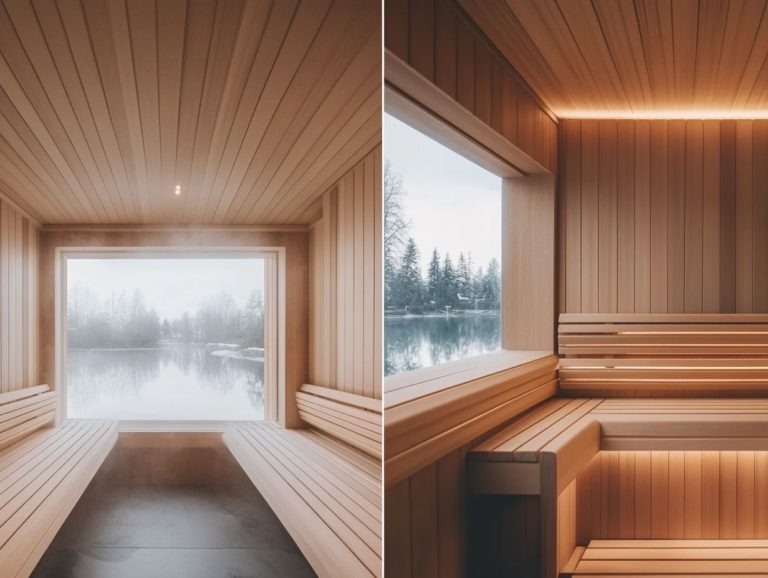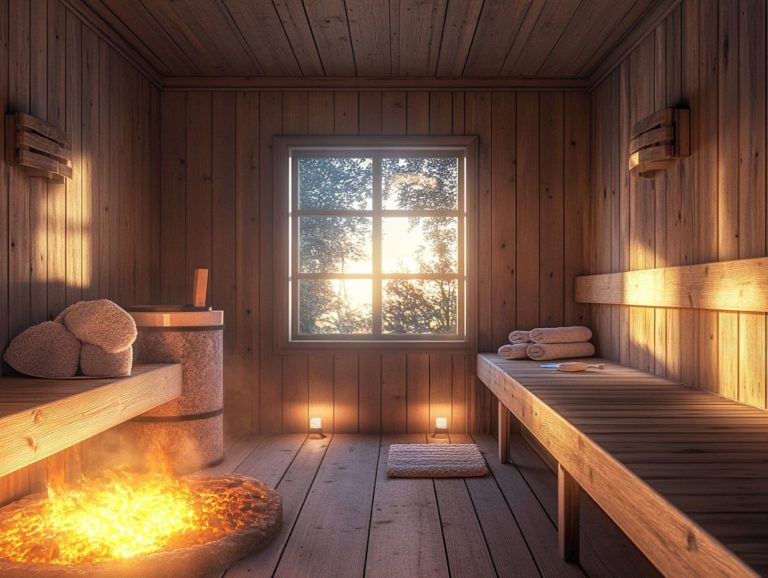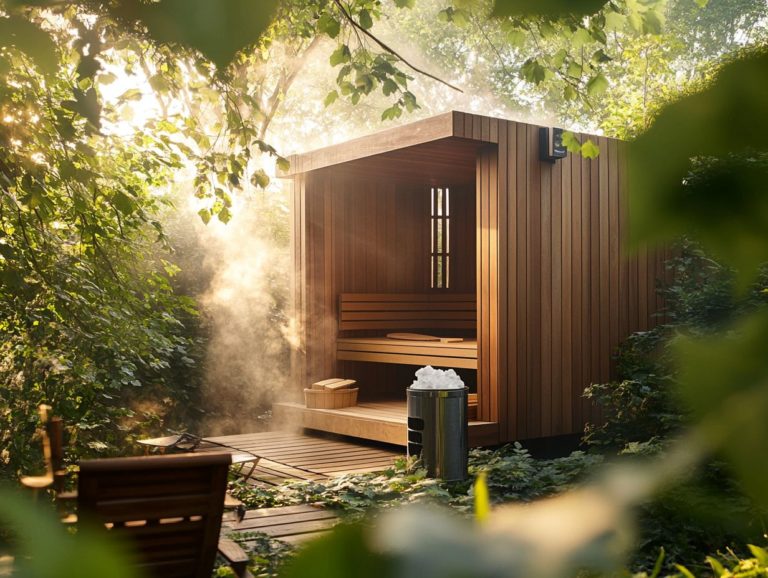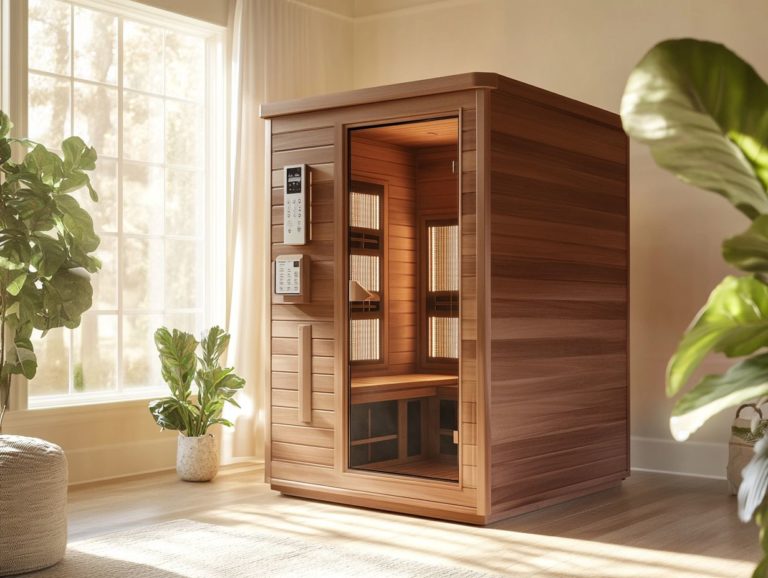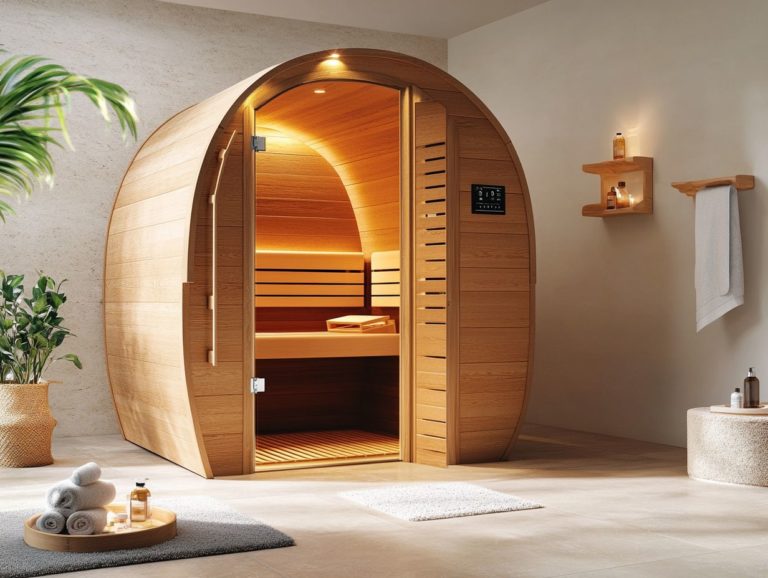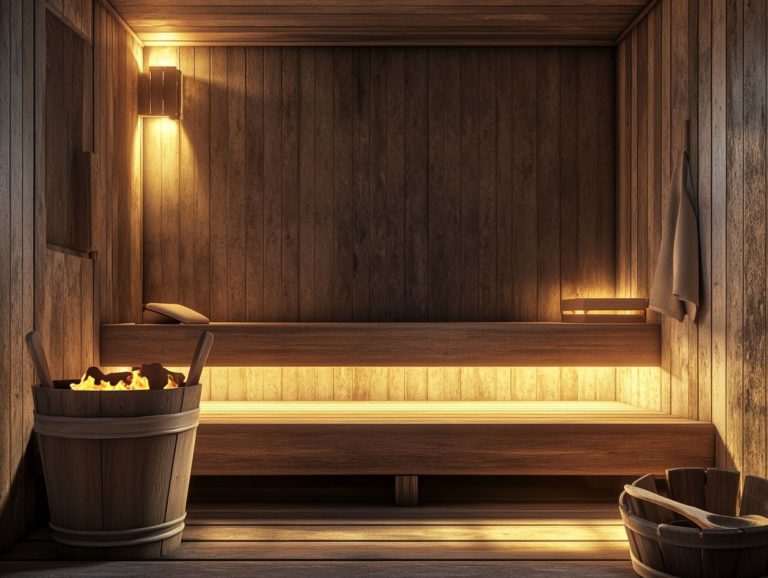Tips for Building Your Own Sauna Type
Dreaming of your own personal oasis? A sauna could be the perfect addition to your home, offering countless health benefits and serving as a sanctuary from daily stressors. Consider the various sauna choices available, such as a DIY sauna project or sauna kits for added convenience.
This article delves into the advantages of having a sauna, key factors to consider before embarking on your journey to build one, and the different types available, including traditional and infrared options. It also provides insights into the sauna construction process and tips from sauna experts.
Explore how to choose the right sauna materials, construct your sauna to perfection, and grasp essential maintenance and safety tips to ensure your sauna experience is both enjoyable and secure.
Transform your space into a relaxing oasis today! Consider integrating a dressing room or a cold plunge for added luxury and comfort.
Contents
- Key Takeaways:
- Benefits of Having a Sauna
- Types of Saunas
- Building Materials and Equipment
- Steps to Building Your Own Sauna
- Constructing the Sauna
- Maintenance and Safety Tips
- Frequently Asked Questions
- What are some important considerations when building your own sauna?
- What materials are commonly used in building saunas?
- Do I need special tools or skills to build a sauna?
- What are some tips for proper sauna ventilation?
- Can I build a sauna outdoors?
- What safety precautions should I consider when building a sauna?
Key Takeaways:
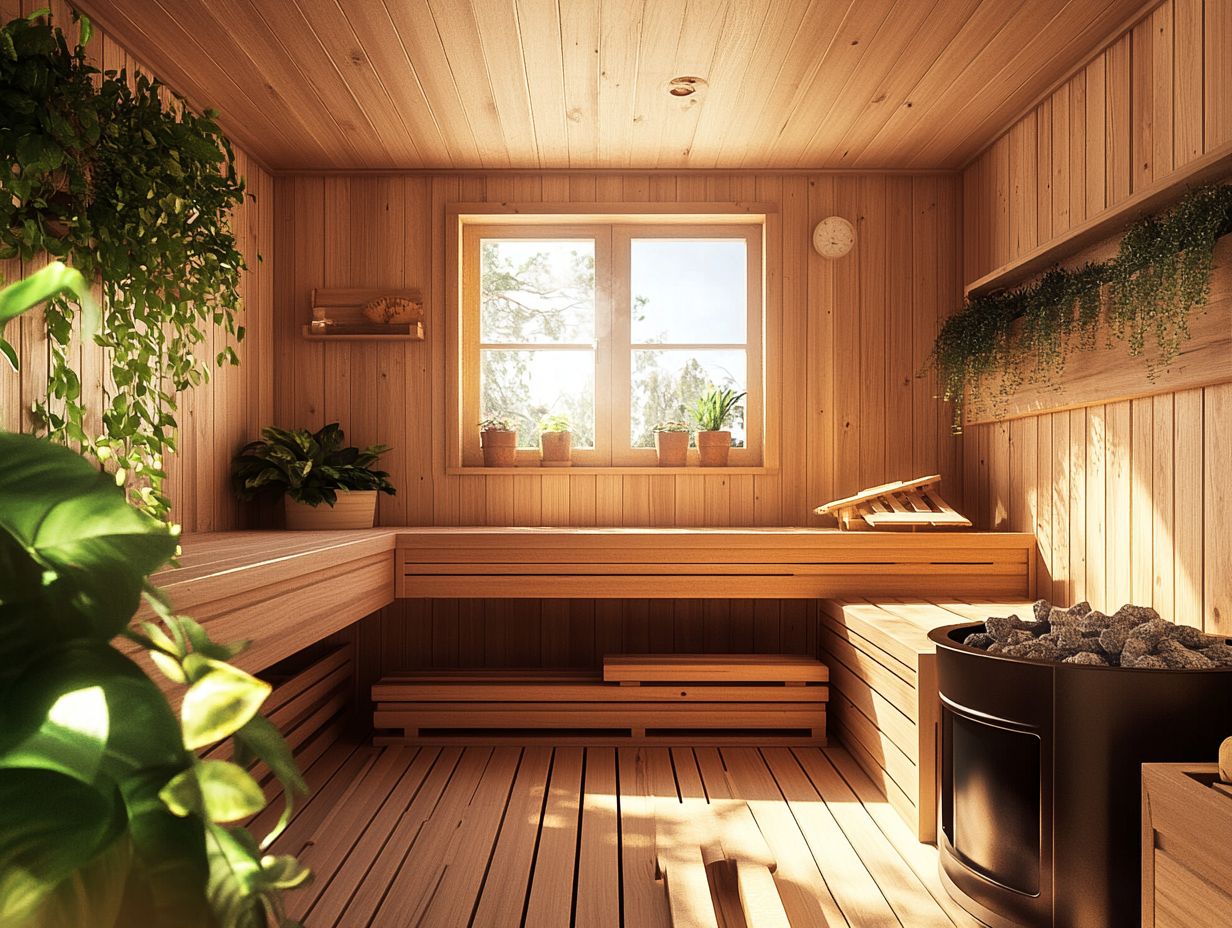
- Consider factors like budget and space before building your sauna.
- Choose the right materials and tools for a safe sauna.
- Regular maintenance is crucial for lasting enjoyment.
Benefits of Having a Sauna
Using a sauna, particularly a Finnish sauna a traditional sauna that uses dry heat presents a wealth of benefits for both your physical and mental well-being. Regular sessions can enhance circulation, promote removing toxins, and facilitate relaxation.
Saunas create a sense of community. They are perfect for socializing while providing a retreat from daily life. Elevating your experience with a cold plunge can further amplify these health benefits, invigorating your body and boosting your metabolism in the most refreshing way, particularly after enjoying a sauna session in your indoor sauna or outdoor sauna.
Factors to Consider Before Building
Before you dive into your sauna construction project, several key factors must be considered to ensure a successful build, whether you’re opting for an indoor or outdoor sauna. Think about the costs involved, the space you have available, and your heating options, such as electric or wood-burning heaters, which are crucial for maintaining the ideal sauna temperature.
Don’t forget about the design elements that will elevate the interior and ambiance of your sauna. Make use of quality sauna paneling and ergonomic bench designs for improved comfort. You might need to enlist professional help from sauna experts for installing an effective ventilation system and using waterproof materials for longevity and efficiency.
It’s essential to evaluate your budget carefully, as that initial investment will play a significant role in determining the quality and lifespan of your sauna, especially when considering sauna kits and the associated sauna costs.
Space considerations are critical; be mindful of the dimensions to ensure comfortable seating and optimal heater placement.
Regarding heating options, each type has its unique characteristics that can affect efficiency and maintenance. The design choices you make, from lighting to materials, including sauna elements like benches and paneling, will significantly influence the overall atmosphere of your sauna.
Working with professionals can guarantee that all structural and functional aspects, especially ventilation and moisture control, are thoroughly addressed, leading to an enjoyable and long-lasting sauna experience that you can share with the sauna community.
Ready to start your sauna journey? Let s explore your options today!
Types of Saunas
Thinking about adding a sauna to your wellness routine? It s important to understand the differences between the various types, especially traditional and infrared saunas.
Traditional saunas are often heated by wood-burning or electric heaters. They provide a warm, cozy environment that is perfect for relaxation.
Infrared saunas are a modern option. They use infrared technology to quickly deliver warmth and are known for being energy efficient.
Traditional vs. Infrared Saunas
Choosing between traditional and infrared saunas depends on your personal preferences. Traditional saunas use heaters to create a high-humidity atmosphere, known for detoxifying benefits.
Infrared saunas heat your body directly, making them more energy-efficient. They are often preferred by those who find traditional saunas too hot.
Understanding these differences can greatly enhance your sauna experience. Traditional saunas foster a communal atmosphere, perfect for socializing.
On the other hand, infrared saunas offer a quieter experience, ideal for meditation or reflection. Each type provides unique benefits tailored to different lifestyles.
Many users appreciate that infrared saunas can improve circulation and ease soreness. They also tend to use less electricity compared to traditional saunas.
Each option has its own perks, allowing you to choose the sauna that fits your needs and health goals.
Building Materials and Equipment
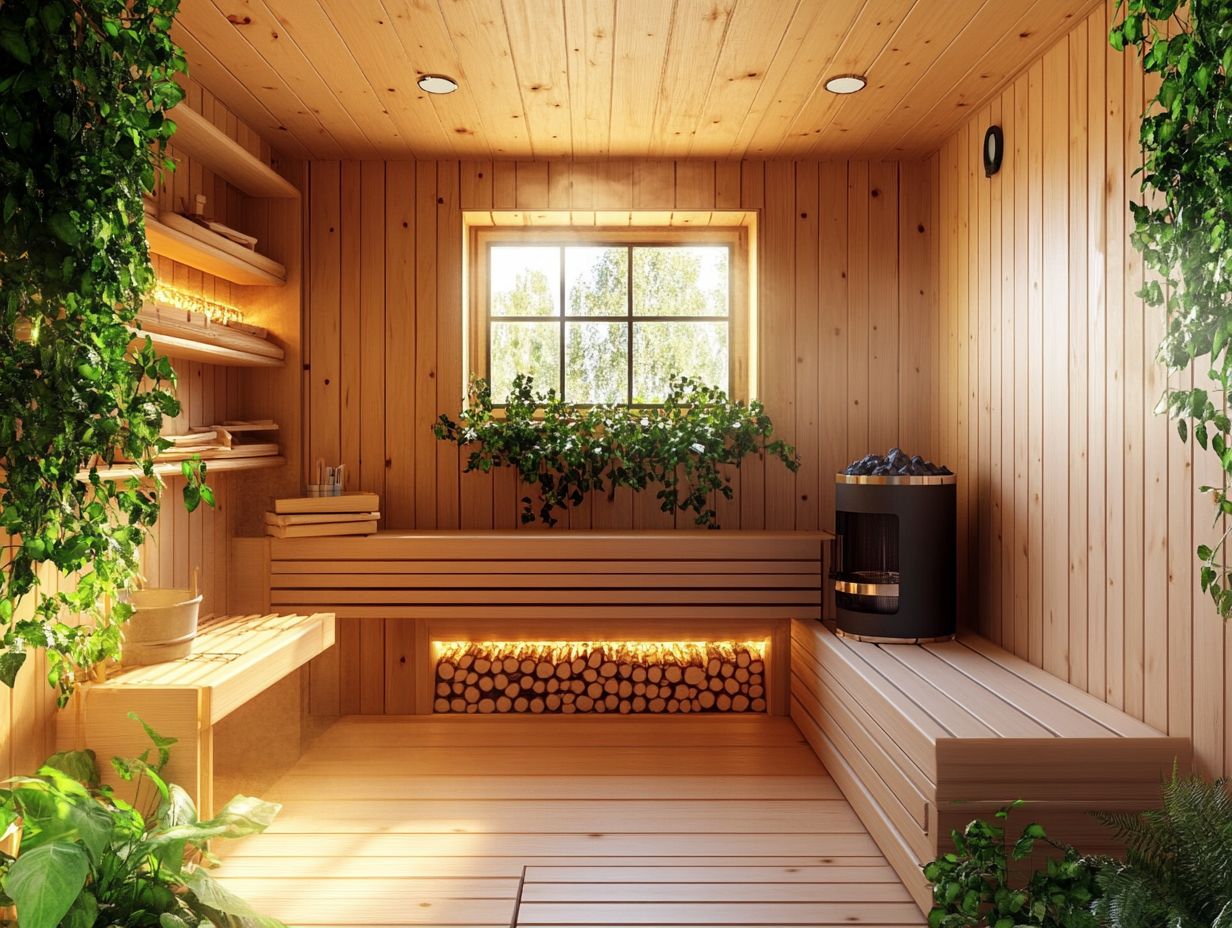
When planning your sauna, choosing the right materials and equipment is crucial. This ensures that your sauna is both functional and inviting.
Cedar wood is a popular choice due to its moisture resistance and pleasant smell. Many sauna retailers recommend it for constructing a sauna.
Fiberglass insulation helps regulate temperature and allows for good air flow. It is essential for comfort and efficiency.
Selecting the right sauna heater is also key. Whether you choose electric or wood-burning, a suitable heater helps achieve the perfect temperature and ambiance.
Choosing the Right Materials and Tools
Selecting the right materials and tools is crucial for your sauna construction project, as they affect how long the sauna lasts and how comfortable it feels. Choosing waterproof materials is essential to keep your sauna in top shape!
You ll want to invest in high-quality sauna paneling and benches crafted from cedar or other suitable woods. This choice enhances comfort and longevity, elevating the ambiance and creating an inviting atmosphere for relaxation.
Having the right tools and equipment on hand streamlines your building process, ensuring a professional finish that reflects your commitment to quality and attention to detail.
Pay special attention to the thermal properties of the wood. Softer woods like cedar are visually appealing and remarkably resilient to high humidity levels typical in sauna environments, which is crucial for a safe and comfortable sauna experience.
Tools like a moisture meter a tool that measures how much moisture is in the wood will be invaluable for confirming that your selected materials can withstand the sauna’s conditions over time.
Incorporating features such as ergonomic bench designs significantly enhances user comfort. This transformation turns your sauna into a true retreat, encouraging social interaction and relaxation.
Proper insulation materials boost efficiency by retaining heat, creating a cozy atmosphere that invites relaxation and fosters a sense of community.
Steps to Building Your Own Sauna
Embarking on a DIY sauna project requires meticulous planning and a methodical approach. This ensures a build that aligns perfectly with your needs and preferences. Begin by evaluating your space and mapping out the sauna layout. Make sure to incorporate adequate drainage to prevent any water damage, which is vital for long-term sauna maintenance.
As you navigate the sauna construction process, it’s wise to seek the expertise of seasoned sauna professionals or sauna companies. Their insights on construction techniques and maintenance strategies can significantly enhance your sauna’s longevity and efficiency, including tips for maintaining your sauna’s exterior.
Planning and Preparing the Space
Planning and preparing the space for your sauna is essential, whether you choose an indoor or outdoor option. This ensures proper placement and harmony with your home design. Carefully consider the sauna layout to align with your home and lifestyle, while catering to those who value socializing and relaxation.
During the planning phase, assess factors like accessibility, privacy, and proximity to water sources. These elements are essential for a practical sauna build.
It s vital to think about how the sauna will harmonize with existing structures and landscaping, enhancing both the aesthetic and functional aspects of your sauna experience.
The orientation of your sauna can greatly affect natural light and ventilation, creating a welcoming atmosphere that complements your sauna layout.
Ensuring a clear and safe path to the sauna enhances your overall experience, particularly during social occasions. Incorporating feedback from potential users helps you design a space that feels inviting, blending personal enjoyment with community engagement.
Striking a balance among these elements results in a sauna experience that is both functional and visually pleasing, encouraging relaxation and social interaction.
Constructing the Sauna
Constructing the sauna is the most exhilarating phase of your sauna build process. This is where your envisioned design starts to materialize. By using high-quality sauna tools, you ensure that every part of the structure is built to last. Pay special attention to insulation, heating, and overall aesthetics. This thoughtful construction using premium materials yields a sauna that offers comfort and efficiency, transforming your relaxation space.
From the foundation to the roofing, each step requires careful planning and precision.
- Start by laying a solid foundation. This is crucial for stability and typically involves concrete or treated wood.
- Choose your insulation material carefully to maintain heat and minimize energy consumption. Foam boards or fiberglass are excellent options.
- When it comes to the heating system, whether you prefer a traditional wood-burning stove or an electric heater, ensure it integrates smoothly into your design for optimal performance.
- Finally, ensure that all finishes, from the wood paneling to the benches, reflect a harmonious blend of functionality and style. This creates a serene environment that enhances relaxation.
Maintenance and Safety Tips
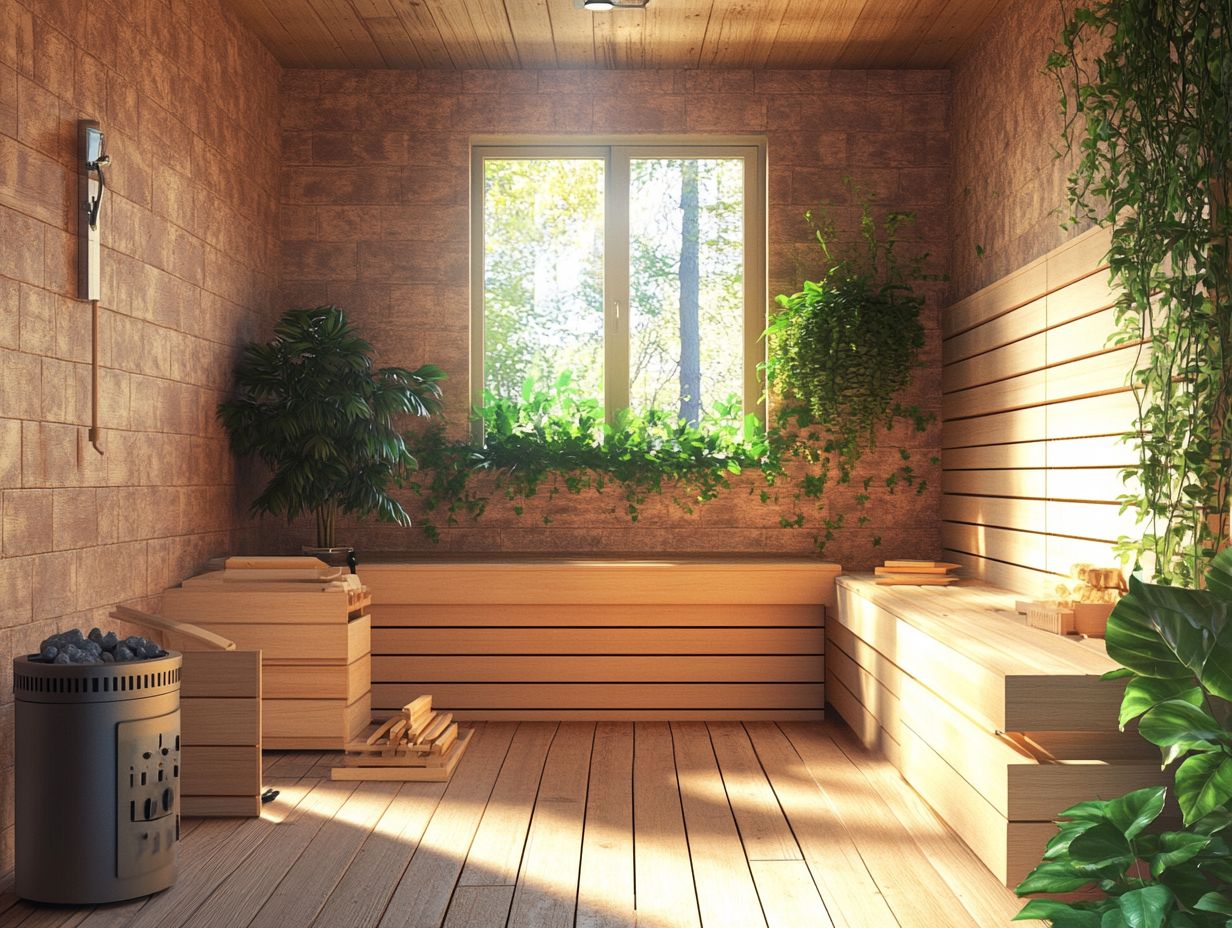
Proper maintenance and safety are essential for a long-lasting and enjoyable sauna experience. Regular upkeep, including thorough cleaning and routine testing of the sauna heater, can extend the life of your sauna. This creates a comfortable atmosphere for you and your guests.
Embrace safety measures like monitoring temperatures and ensuring adequate ventilation. These practices enhance the overall safety of your sauna, protecting you and cultivating a responsible sauna community.
Proper Cleaning and Maintenance
Maintaining a clean and efficient sauna is crucial for preserving its interior and ensuring an enjoyable experience. By regularly using the right sauna cleaning tools, you can prevent moisture and mildew buildup. This protects how strong your sauna is and your comfort.
Use a soft-bristle brush for wooden elements. It gently removes dirt without scratching. A mixture of vinegar and water is excellent for wiping down surfaces and eliminating odors while avoiding harsh chemicals.
Proper ventilation is vital for reducing moisture. This helps maintain a dry environment and prolongs the life of your heater. Regularly check for scale buildup on the heater and schedule semi-annual professional inspections for efficient operation.
By integrating these practices into your routine, you ll keep your sauna a sanctuary of relaxation and rejuvenation.
Ensuring Safety While Using the Sauna
Ensuring safety while using the sauna enhances your comfort and the overall experience for everyone involved. Keep an eye on the sauna temperature, ensure proper ventilation, and stay hydrated to avoid overheating.
Be mindful of your own physical limits to prevent unnecessary stress. Agree on appropriate heat levels with others, allowing everyone to acclimate at their own pace.
Encourage practices like bringing water bottles and sharing knowledge about signs of dehydration. This fosters a supportive atmosphere. By respecting each other s space and keeping the environment noise-free, you enhance the enjoyment of the sauna.
Ultimately, prioritizing these safety practices leads to a more inclusive and relaxing sauna experience for everyone involved.
Frequently Asked Questions
What are some important considerations when building your own sauna?
When building your sauna, consider:
- Size and location of the sauna
- Choosing the right materials
- Ensuring proper ventilation and insulation
- Following safety guidelines
Start planning your sauna today!
What materials are commonly used in building saunas?
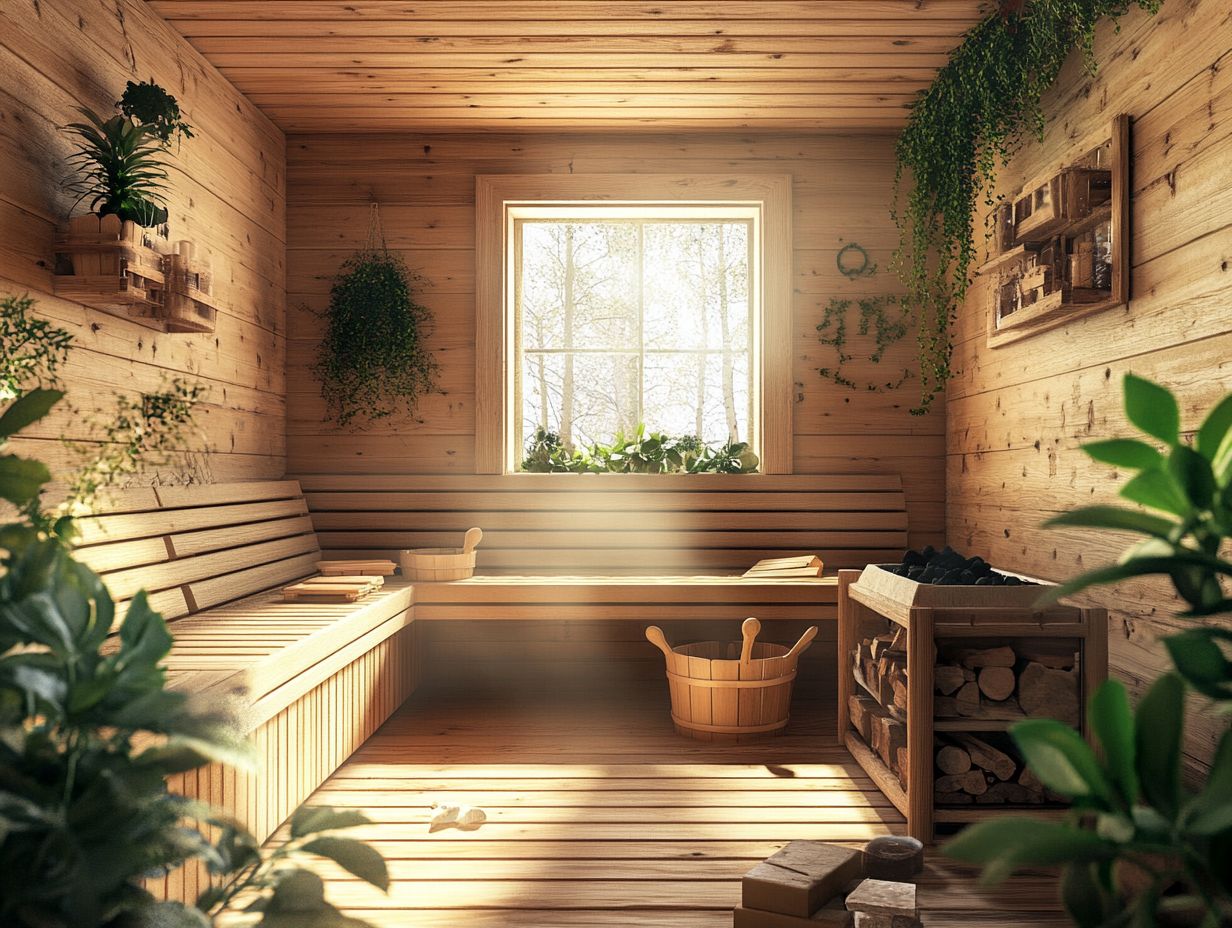
Common materials for building saunas include cedar wood, stone, and brick. Choose materials that can handle high heat and moisture.
Do I need special tools or skills to build a sauna?
You ll need some DIY skills and tools, but building a sauna can be a fun project for many homeowners. If you’re unsure of your skills, it’s wise to get professional help.
What are some tips for proper sauna ventilation?
Good airflow is essential for a safe sauna experience! Make sure to have both a lower and upper vent, plus a door or window for extra airflow.
Regularly clean and maintain the vents to prevent mold and mildew.
Can I build a sauna outdoors?
Absolutely! Building a sauna outdoors is a great option. Just make sure to use materials and insulation that can withstand the weather.
Having a roof or shelter for your sauna will protect it from rain and snow damage.
What safety precautions should I consider when building a sauna?
Keeping safe should be your top priority! Follow building codes and regulations, use the right materials, and install features like temperature controls and emergency exits.
Remember to regularly inspect and maintain your sauna to avoid hazards!

